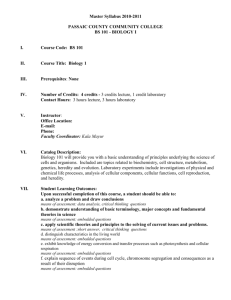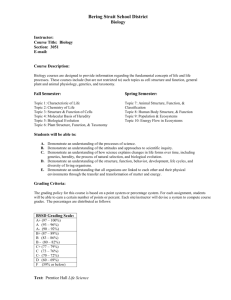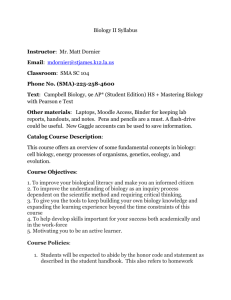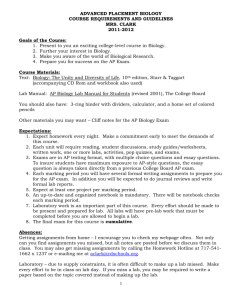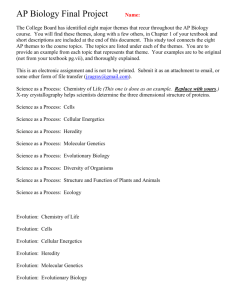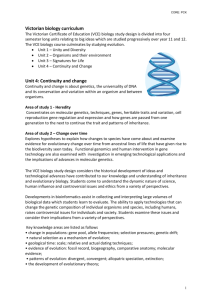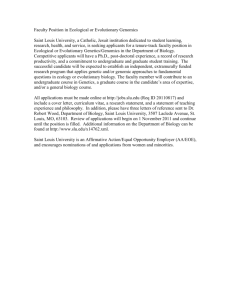First Quarter Topics and Laboratories
advertisement
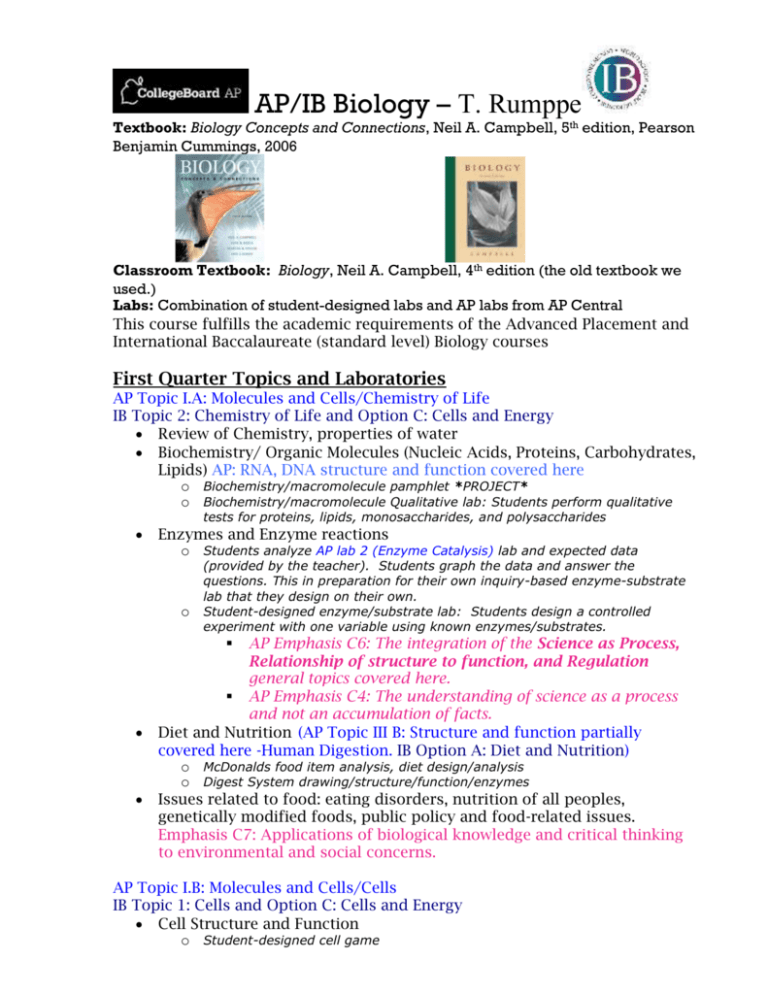
AP/IB Biology – T. Rumppe Textbook: Biology Concepts and Connections, Neil A. Campbell, 5th edition, Pearson Benjamin Cummings, 2006 Classroom Textbook: Biology, Neil A. Campbell, 4th edition (the old textbook we used.) Labs: Combination of student-designed labs and AP labs from AP Central This course fulfills the academic requirements of the Advanced Placement and International Baccalaureate (standard level) Biology courses First Quarter Topics and Laboratories AP Topic I.A: Molecules and Cells/Chemistry of Life IB Topic 2: Chemistry of Life and Option C: Cells and Energy Review of Chemistry, properties of water Biochemistry/ Organic Molecules (Nucleic Acids, Proteins, Carbohydrates, Lipids) AP: RNA, DNA structure and function covered here o Biochemistry/macromolecule pamphlet *PROJECT* o Biochemistry/macromolecule Qualitative lab: Students perform qualitative tests for proteins, lipids, monosaccharides, and polysaccharides Enzymes and Enzyme reactions o Students analyze AP lab 2 (Enzyme Catalysis) lab and expected data o (provided by the teacher). Students graph the data and answer the questions. This in preparation for their own inquiry-based enzyme-substrate lab that they design on their own. Student-designed enzyme/substrate lab: Students design a controlled experiment with one variable using known enzymes/substrates. AP Emphasis C6: The integration of the Science as Process, Relationship of structure to function, and Regulation general topics covered here. AP Emphasis C4: The understanding of science as a process and not an accumulation of facts. Diet and Nutrition (AP Topic III B: Structure and function partially covered here -Human Digestion. IB Option A: Diet and Nutrition) o McDonalds food item analysis, diet design/analysis o Digest System drawing/structure/function/enzymes Issues related to food: eating disorders, nutrition of all peoples, genetically modified foods, public policy and food-related issues. Emphasis C7: Applications of biological knowledge and critical thinking to environmental and social concerns. AP Topic I.B: Molecules and Cells/Cells IB Topic 1: Cells and Option C: Cells and Energy Cell Structure and Function o Student-designed cell game o Microscopy - cells: sizes, drawings, organelle ID Cell membrane, osmosis, diffusion o Diffusion/Osmosis lab, Water potential of potato AP lab 1 Mitosis o Cells in mitosis lab (whitefish blastula/onion root tip) Meiosis Focus on heredity and evolution, especially variation and adaptation. o Natural Selection will be introduced here. o Students will be given old IB test questions that relate biochemistry and its use as ‘evolutionary clock’ to determine when certain organisms diverted from each other in evolutionary development. This in turn will be related to meiosis again. The course provides students with an opportunity to develop a conceptual framework for modern biology emphasizing the integration of the general topics of biology through the eight major themes as specified in the Course Description: Science as Process; Evolution; Energy Transfer; Continuity and Change; Relationship of structure to function; Regulation; Interdependence in nature; Science, technology, and society. o (Introduction to AP Topic II.A: Heredity, AP Topic II.B: Molecular Genetics, AP Topic III A: Organisms and populations/Diversity, AP Topic II C: Evolutionary biology) Emphasis C5: The recognition of evolution as the foundation of modern biological models and thought. o Emphasis C1: Molecules and Cells o Emphasis C2 hereditary and evolution o AP lab 3: Mitosis and meiosis (mitosis covered earlier) Continued introduction to heredity, variation, and adaptation: Students watch Cracking the Code of Life, (Nova, 2001). This video also found online: www.pbs.org/wgbh/nova/genome/ and can be viewed by students at home. o Topics for discussion: Gene patenting and the ethics related to this. How does natural selection apply today? How does this relate to other ethical considerations of today (stem cell research, genetically modified foods, the role of science in public policy)? o Emphasis C6: The integration of the Science as Process, o Relationship of structure to function, Continuity and Change, Evolution, Science, Technology and Society, Interdependence in nature, and Regulation general topics covered here. o Emphasis C7: Applications of biological knowledge and critical thinking to environmental and social concerns. Second Quarter Topics and Laboratories AP Topic I.C: Molecules and Cells/Cellular Energetics IB Topic 2: Chemistry of Life and Option C: Cells and Energy Energy relationships/ATP Photosynthesis o Photosynthesis analogy Project: Students use an analogy to describe all of the oxidation/reduction reactions of light-dependant reactions of photosynthesis o Spectrophotometer lab: collect, analyze absorption spectrum o AP lab 4 Plant pigments and Photosynthesis Chromotagraphy portion of this lab is done in class. Data from the o Photosynthesis portion of the AP lab (provided by the teacher) is graphed and analyzed.Questions from AP lab answered. Self-designed photosynthesis lab done by the students. Emphasis C6: The integration of the Science as Process, Relationship of structure to function, Energy transfer, Interdependence in nature, and Regulation general topics covered here. Emphasis C4: The understanding of science as a process and not an accumulation of facts. Respiration o AP lab 5 Cell respiration: Students analyze data provided by the teacher for this lab. o They graph, analyze and answer questions related to the data. This is an introduction to set up an inquiry-based-self-designed respiration lab. Student-designed respiration or fermentation lab o Emphasis C6: The integration of the Science as Process, Relationship of structure to function, Energy transfer, Interdependence in nature, and Regulation general topics covered here. o Emphasis C4: The understanding of science as a process and not an accumulation of facts. Third Quarter Topics and Laboratories AP Topic II.A: Heredity IB Topic 3: Genetics Review of Meiosis/gametogenesis Genetics o o o AP lab 7 Genetics of organisms, substitutions: Students do virtual labs mating Drosophila melanogaster and cats. The Drosophila Website: bioweb.wku.edu/courses/Biol114/Vfly1.asp AP lab 8 Population Genetics and Evolution. Students study and analyze Hardy-Weinberg equilibrium. Emphasis C2 hereditary and evolution AP Topic II.B: Molecular Genetics Protein synthesis o Protein Synthesis Model DNA electrophoresis/Genetic Technology o DNA Electrophoresis/Restriction Enzyme lab AP lab 6 o Emphasis C2 hereditary and evolution AP Topic III B: Organisms and populations/Structure and Functions of plants and animals. IB Topic 5: Human Health and physiology Immunity Circulatory systems Respiratory systems Reproductive Systems Nervous systems Homeostasis o Group 4 Project: Student-designed and implemented laboratory project (Done independently outside of class.) o Pig Heart observation/dissection o AP lab 10 Physiology of the Circulatory System modified to use fish and in conjunction with cardiologist (speaker) Fourth Quarter Topics and Laboratories AP Topic III A: Organisms and populations/Diversity AP Topic II C: Evolutionary biology IB Topic 4: Ecology and Evolution Classification/survey of life/evolution and evolutionary patterns o Diversity of organisms o Review of Natural Selection, population genetics, and adaptations. o Survey of plant and animal differences. Students will study how plants and animals reproduce, transport materials, get rid of waste, obtain energy, grow, move, adapt to their environment, perform gas exchange and maintain homeostasis. Overview of phylogenic characteristics studied in the context of how the organisms (if they did) made the transfer from living in an aqueous environment, to living on land. Emphasis C2 hereditary and evolution. Emphasis C3 Organisms and populations. Emphasis C6 Interdependence in nature, Evolution, Energy Transfer, Regulation, Science Technology and Society. Class Stations on the following: Plant/Flower dissection Bilateral Key. Tree identification activity AP lab 10: Transpiration lab data analyzed AP lab 11: Animal Behavior lab modified for meal worms AP lab 12: dissolved Oxygen and Primary Productivity lab Mechanisms of evolution o Review of Natural Selection, meiosis, Hardy-Weinberg o Populations AP Topic III C: Organisms and populations/Ecology IB Topic 4: Ecology and Evolution Energy flows Resource cycles Habitats/ Biomes Human Impact o Student seminars on a current topic in ecology. The seminar must cover habitats, energy and other resources, plant/animal impacts, human impacts, ethics, the political aspects of the topic as well as the biological implications. o Emphasis C6 Interdependence in nature, Evolution, Energy Transfer, Regulation, Science Technology and Society. Review for the tests Format Philosophically, I believe that it is essential to utilize as many areas of the brain as possible. Retention/retrieval of material is gained if the material is stored in many areas of the brain. Many lessons incorporate design, presentation, 3-D modeling, drawing, or music. Cooperative learning groups have been a benefit to students –especially study groups. Please see me if you are interested in brain research on memory and retention that supports this teaching style. (Howard Eichenbaum and Neal J. Cohen, Nancy Andreason, James E. Zull, David Kolb, to name a few researchers) 1. Students will have an IB/AP syllabus notebook. a. Every day, students will have a topic from the syllabus. b. They will be asked to paraphrase the topic, draw a picture or further explain the premise of the topic. (My goal is to focus more on the IB/AP topic requirements… I will still give my lecture notes at the end of the year to the students taking the exam, but I feel that this approach makes the syllabus more personal.) 2. Students will have an IB/AP syllabus quiz where they can use their notebook to take a short quiz using questions from old IB/AP tests. 3. Extra credit will involve paraphrasing topics that we don’t get to… IB/AP truths that will help you succeed: 1. Study with others. Have Biology parties. Talk over the material. (I think that study parties are so essential that I will give extra credit to any student that hosts a party and announces it in class for all to attend!) 2. 3. 4. 5. 6. 7. Ask for help when you need it. Read the textbook. Re-read the difficult portions. Skim the chapter first… then tackle the whole thing. Laugh. Retention is higher if a concept can be tied to an emotion… Cry only as needed or as a last resort! Get access to an Internet connection. My lectures and most worksheets are online. (The media Center is keeping late hours this year.) Know my web page: (or ‘google’ teresa rumppe) http://southwest.mpls.k12.mn.us/Rumppe.html Know my email: trumppe@mpls.k12.mn.us CRITERIA FOR LABORATORY WRITTEN WORK 1. Planning A (Introduction) ________ Background information is provided ________ Nature of the problem is described ________ Purpose is stated ________ Qualitative information is described (characteristics that might influence the nature of the problem, or affect the experiment.) ________ Hypothesis is stated. (IB states: “A typical formulation for a hypothesis might be “if … is done, then …… will occur”.”) The best hypothesis is quantitative: “If A is doubled, then B will triple…” 2. Planning B (Procedure) ________ Materials listed ________ Methods described ________ Methods justified ________ Control is listed and identified ________ Measurement of variables is described 3. Data Collection (Results) ________ Table of quantitative data ________ Units of measurement are identified ________ Range of precision is identified ________ Qualitative data is written in either the table or as additional data 4. Data Analysis (Graphs) ________ Graph has a title, ________ Axes are labeled with units ________ Key is provided (if needed) ________ Graph is appropriate for the data collected 5. Evaluation (Discussion and Conclusion) ________ Analysis of results ________ Evaluation of hypothesis ________ Evaluation of procedure ________ Suggestions of procedure modification Random Rules: 1. 2. 3. 4. 5. 6. 7. 8. 9. Passes from a planner only. No passes for first or last 10 minutes of class. No food or drink (for your own safety.) You are absent from the class if you walk in 5 minutes after the last bell without a pass. Late work will be accepted with a 10% deduction for 1 week (it turns to a permanent zero after 1 week.) Tests can be retaken 1 time after school or during lunch for full credit. Tests must be taken or retaken within 1 week of the original scheduled exam. Absolutely no throwing (or pretending to throw.) Cell phones, walkmans, and hats need to be off and hidden. Grading 15% Syllabus notes and notebook 35% homework/lab write-ups 15% Activities and Presentations 35% tests and quizzes Of the total points: 90% - 100% = A- to A 80% - 89% = B- to B+ 70% - 79% = C- to C+ 60% - 69% = D- to D+ Parent/Guardian signature:__________________________________ Parent/Guardian email:_____________________________________ Student signature:_________________________________________ Student email:____________________________________________ “R”-rated movies: I don’t show ‘R-rated feature films’ but I have shown Autopsy videos. Please let me know if you object to this… Appendix: Media Release form (on the back): If you don’t mind having your student’s picture on the web page (no names will be included…) please sign the form on the other side of this page. No guarantees of display unless you provide the picture to me in a digital format (email), however.




